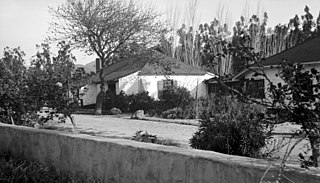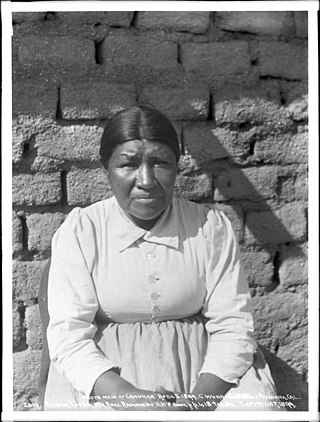Related Research Articles

Boron is a census-designated place (CDP) in Kern County, California, United States. Boron is 15 miles (24 km) southwest of Red Rock Mountain at an elevation of 2,467 feet (752 m). The population was 2,086 at the 2020 census, up from 2,025 at the 2000 census. Boron is named after the element boron and is the site of the world's largest source of the boron compound boric acid.

Calico is a ghost town and former mining town in San Bernardino County, California, United States. Located in the Calico Mountains of the Mojave Desert region of Southern California, it was founded in 1881 as a silver mining town, and was later converted into a county park named Calico Ghost Town. Located off Interstate 15, it lies 3 miles (4.8 km) from Barstow and 3 miles from Yermo. Giant letters spelling CALICO are visible, from the highway, on the Calico Peaks behind it. Walter Knott purchased Calico in the 1950s, and architecturally restored all but the five remaining original buildings to look as they did in the 1880s. Calico received California Historical Landmark #782, and in 2005 was proclaimed by then-Governor Arnold Schwarzenegger to be California's Silver Rush Ghost Town.

Bodie is a ghost town in the Bodie Hills east of the Sierra Nevada mountain range in Mono County, California, United States. It is about 75 miles (121 km) southeast of Lake Tahoe, and 12 mi (19 km) east-southeast of Bridgeport, at an elevation of 8,379 feet (2554 m). Bodie became a boom town in 1876 after the discovery of a profitable line of gold; by 1879 it had a population of 7,000–10,000.

Norman Eugene "Clint" Walker was an American actor. He played cowboy Cheyenne Bodie in the ABC/Warner Bros. western series Cheyenne from 1955 to 1963.

Rancho Camulos, now known as Rancho Camulos Museum, is a ranch located in the Santa Clara River Valley 2.2 miles (3.5 km) east of Piru, California and just north of the Santa Clara River, in Ventura County, California. It was the home of Ygnacio del Valle, a Californio alcalde of the Pueblo de Los Angeles in the 19th century and later elected member of the California State Assembly. The ranch was known as the Home of Ramona because it was widely believed to have been the setting of the popular 1884 novel Ramona by Helen Hunt Jackson. The novel helped to raise awareness about the Californio lifestyle and romanticized "the mission and rancho era of California history."
The term sense of place has been used in many different ways. It is a multidimensional, complex construct used to characterize the relationship between people and spatial settings. It is a characteristic that some geographic places have and some do not, while to others it is a feeling or perception held by people. It is often used in relation to those characteristics that make a place special or unique, as well as to those that foster a sense of authentic human attachment and belonging. Others, such as geographer Yi-Fu Tuan, have pointed to senses of place that are not "positive," such as fear. Some students and educators engage in "place-based education" in order to improve their "sense(s) of place," as well as to use various aspects of place as educational tools in general. The term is used in urban and rural studies in relation to place-making and place-attachment of communities to their environment or homeland. The term sense of place is used to describe how someone perceives and experiences a place or environment. Anthropologists Steven Feld and Keith Basso define sense of place as: 'the experiential and expressive ways places are known, imagined, yearned for, held, remembered, voiced, lived, contested and struggled over […]’. Many indigenous cultures are losing their sense of place because of climate change and "ancestral homeland, land rights and retention of sacred places".

Edward William Soja was a self-described urbanist, a noted postmodern political geographer and urban theorist on the planning faculty at UCLA, where he was Distinguished Professor of Urban Planning, and the London School of Economics. He had a Ph.D. from Syracuse University. His early research focused on planning in Kenya, but Soja came to be known as the world's leading spatial theorist with a distinguished career writing on spatial formations and social justice.
Neil Robert Smith was a Scottish geographer and academic. He was Distinguished Professor of Anthropology and Geography at the Graduate Center of the City University of New York, and winner of numerous awards, including the Globe Book Award of the Association of American Geographers.

Erwin Raisz was a Hungarian-born American cartographer, best known for his physiographic maps of landforms.
William Wheeler Bunge Jr. was an American geographer active mainly as a quantitative geographer and spatial theorist. He also became a radical geographer and anti-war activist in the US and Canada.

The Tatra 87 (T87) is a car built by Czechoslovak manufacturer Tatra. It was powered by a rear-mounted 2.9-litre air-cooled 90-degree overhead cam V8 engine that produced 85 horsepower and could drive the car at nearly 100 mph (160 km/h). It is ranked among the fastest production cars of its time. Competing cars in this class, however, used engines with almost twice the displacement, and with fuel consumption of 20 liters per 100 km. Thanks to its aerodynamic shape, the Tatra 87 had a consumption of just 12.5 litres per 100 km. After the war between 1950 and 1953, T87s were fitted with more-modern 2.5-litre V8 T603 engines.

The Casa de Estudillo, also known as the Estudillo House, is a historic adobe house in San Diego, California, United States. It was constructed in 1827 by José María Estudillo and his son José Antonio Estudillo, early settlers of San Diego and members of the prominent Estudillo family of California, and was considered one of the finest houses in Mexican California. It is located in Old Town San Diego State Historic Park, and is designated as both a National and a California Historical Landmark in its own right.
The Legend of Pancho Barnes and the Happy Bottom Riding Club is a 2009 American documentary film that chronicles the life of aviation pioneer Florence Lowe "Pancho" Barnes.
David Matthew Sandner is an author and editor of fantasy literature and a professor at California State University, Fullerton.

Dawn Jeannine Wright is an American geographer and oceanographer. She is a leading authority in the application of geographic information system (GIS) technology to the field of ocean and coastal science, and played a key role in creating the first GIS data model for the oceans. Wright is Chief Scientist of the Environmental Systems Research Institute. She has also been a professor of geography and oceanography at Oregon State University since 1995 and is a former Oregon Professor of the Year as named by the Council for the Advancement and Support of Education and the Carnegie Foundation for the Advancement of Teaching. Wright was the first African-American female to dive to the ocean floor in the deep submersible ALVIN. On July 12, 2022 she became the first Black person to dive to Challenger Deep, the deepest point on Earth, and to successfully operate a sidescan sonar at full-ocean depth.
Paul Wheatley was a geographer who came to specialize in the historical geography of Southeast Asia and East Asia.
The Las Vegas Mission was one of the earliest European settlements in the Las Vegas Valley. It was established by missionaries for the Church of Jesus Christ of Latter-day Saints, or Mormons. In May 1855, at the direction of then Church President Brigham Young, thirty-two missionaries were sent to evangelize among Native Americans and establish a mission outpost in the Las Vegas Valley. The mission was abandoned in December 1857 due to growing political issues revolving Mormons and the threat of Native American attacks.

Mazie Oylee Tyson was an American geographer who taught at historically-black colleges from the 1920s into the 1970s, including over twenty years at Tennessee State College.

Ramona Lubo (1865–1922) was a Cahuilla basketmaker known as the "real Ramona" who gained popularity from her association with the novel Ramona by Helen Hunt Jackson.
Richard Joel Russell was an American professor of physical geography and geology at the Louisiana State University who contributed to pioneering studies of long-term climatology and geomorphology.
References
- ↑ DeLyser, Dydia. (2005). Ramona memories : tourism and the shaping of Southern California . Minneapolis: University of Minnesota Press. ISBN 0-8166-4571-X. OCLC 56682518.
- ↑ "Pair sheds new light on L.A.'s claim to neon fame". Los Angeles Times. 2013-12-03. Retrieved 2019-11-23.
- ↑ Delyser, Dydia (2014-03-01). "Tracing absence: Enduring methods, empirical research and a quest for the first neon sign in the USA". Area. 46: 40–49. doi:10.1111/area.12076.
- ↑ "Dydia_DeLyser - Department of Geography & the Environment | CSUF". geography.fullerton.edu. Retrieved 2019-11-23.
- ↑ DeLyser, Dydia (1998). Good, by God, we're going to Bodie! Landscape and social memory in a California ghost town (PhD dissertation). Syracuse University. ISBN 978-0-599-00614-0. ProQuest 304471070.
- ↑ DeLyser, Dydia (1999). "Authenticity on the Ground: Engaging the Past in a California Ghost Town". Annals of the Association of American Geographers. 89 (4): 602–632. doi:10.1111/0004-5608.00164. ISSN 0004-5608. JSTOR 2564461.
- ↑ "The Most Famous Ghost Town in America". Discover Magazine. Retrieved 2019-11-23.
- ↑ "1941 Tatra T87: The Jalopnik Classic Review". Jalopnik. 3 April 2014. Retrieved 2019-11-23.
- ↑ Tellem, Tori (2010-07-23). "Votes Are In, and the Fin Has Won". The New York Times. ISSN 0362-4331 . Retrieved 2019-11-23.